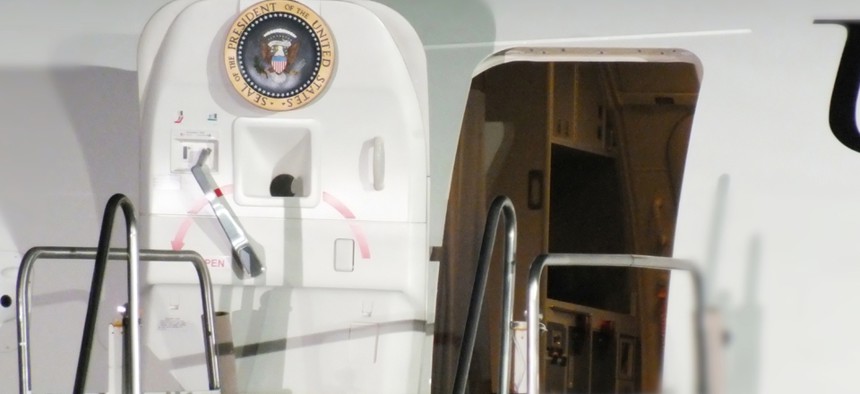
A BCD Creative / Shutterstock.com
Why It's Increasingly Difficult for Anyone to Be President of the Entire United States
Structural forces are making it hard for any leader to function as more than 'the president of half of America.'
The unconstrained political warfare symbolized by House Speaker John Boehner's pledge to sue President Obama for allegedly abusing his executive authority pushes this presidency farther down a rocky road that Bill Clinton and George W. Bush would painfully recognize.
In one key respect, each president's tenure has followed a similar arc. Each initially sought the White House promising to bridge the nation's widening partisan divide. Clinton pledged to transcend "brain-dead policies in both parties" with his "New Democrat" agenda. Bush declared himself a "compassionate conservative" who would govern as "a uniter, not a divider." Obama emerged with his stirring 2004 Democratic convention speech, evoking the shared aspirations of red and blue America, and took office embodying convergence and reconciliation.
But by this point in their respective second terms, each man faced the stark reality that the country was more divided than it was when he took office. In 1996 and 1997, Clinton reached Washington's most consequential bipartisan agreements (particularly to reform welfare and balance the budget) since the early 1970s. But by 1998, House Republicans were moving inexorably toward their vote to impeach him.
Bush enjoyed some bipartisan first-term successes, particularly on education reform. But by this point in his second term, he was fighting with Democrats over the Iraq War and restructuring Social Security, and with House Republicans over reforming immigration. Obama, from his first weeks, has faced unremitting Republican opposition. And, as his shift toward unilateral executive action underscores, he's increasingly thrown up his hands at the possibility of finding any common ground with the GOP.
Clinton pursued agreements across party lines more consistently than either Bush or Obama. But this persistent polarization likely owes less to the three men's specific choices than to structural forces that are increasingly preventing any leader, no matter how well-intentioned, from functioning as more than "the president of half of America."
That phrase, coined by Will Marshall, president of the centrist Progressive Policy Institute, aptly describes an environment in which presidents now find it almost impossible to sustain public or legislative support beyond their core coalition.
That dynamic is partly explained by institutional changes that have transformed Congress into a quasi-parliamentary institution and hindered presidents from building productive partnerships with the opposite party.
The move by both parties to rely less on seniority and more on votes by their full membership when allocating coveted committee chairmanships has increased pressure on legislators to toe the party line, which almost always discourages cooperation with the other side. The rise of national fundraising networks to bankroll more primary challenges has reinforced that effect: Legislators today are denied renomination for compromising too much, not too little. And the roar of overtly liberal and conservative media has provided each party's ideological vanguard another powerful cudgel against legislators tempted to stray.
But these changes only manifest a deeper divide in the public itself. In elections up and down the ballot, each party now relies on voter coalitions that overlap remarkably little with each other in their demography, geography—or priorities. Democrats depend on a coalition that is younger, racially diverse, more secular, and heavily urbanized. Republicans mobilize a mirror-image coalition that is older, more religiously devout, largely nonurban, and preponderantly white. Satisfying one coalition without alienating the other has become daunting, and many activists, especially in the GOP, now see any attempt at compromise between them as capitulation.
The latest political "typology" poll from the nonpartisan Pew Research Center, which tracks bedrock attitudes about American life, captures the gaping distance between these coalitions—and the offsetting strengths that leave them so closely matched.
The survey finds a consistent tilt, ranging from slight to lopsided, toward Democratic views on cultural questions. The share of Americans who support gay marriage has exactly doubled since 1996 to 54 percent; a narrow majority backs abortion; three-fourths of adults (including big majorities of minorities and whites) say immigrants here illegally eventually should be allowed to obtain citizenship. In other polls, majorities endorse universal gun-purchase background checks and Obama's contraception mandate.
But on Pew questions about government's role, the country leaned slightly toward Republican arguments. Just over half (including about three-fifths of whites) say government is doing too much; respondents split evenly on whether government aid to the poor now mostly helps or instead fosters excessive dependence. Most say government can't afford more aid to the needy. In other surveys, relatively few Americans say they have benefited from Obama's economic or health care initiatives.
The groups most drawn to Democratic arguments, particularly on cultural issues (minorities, millennials, and college-educated white women), are growing, which should boost the party over the long term. But Democrats' inability to sell much of the white middle class on government activism gives Republicans a countervailing advantage. These contrasting strengths present a formula for an extended electoral standoff that denies either party a lasting advantage anytime soon. That means more confrontation and stalemates in Washington—and more presidents who can't muster the support of more than half of America.
(Image via A BCD Creative / Shutterstock.com)







